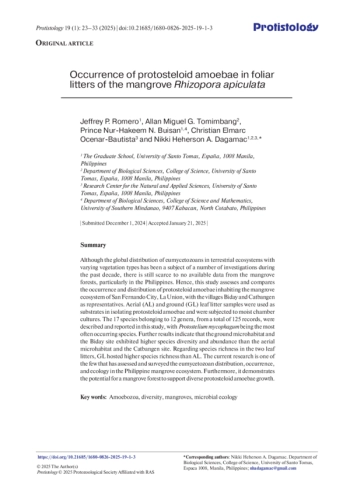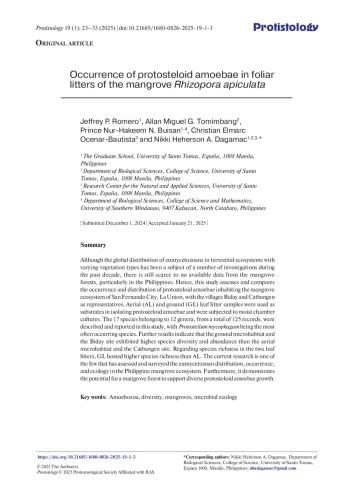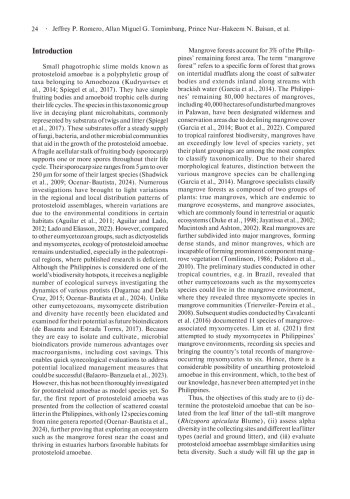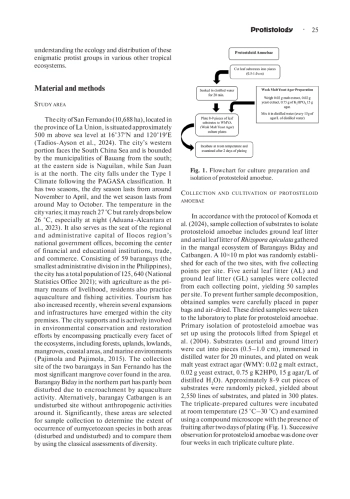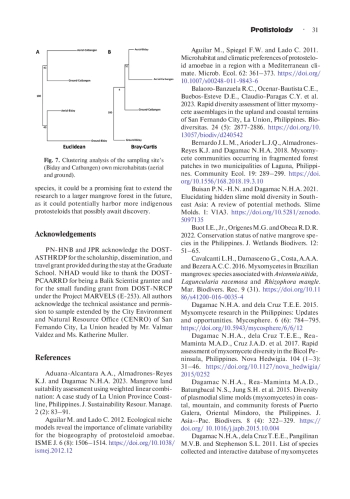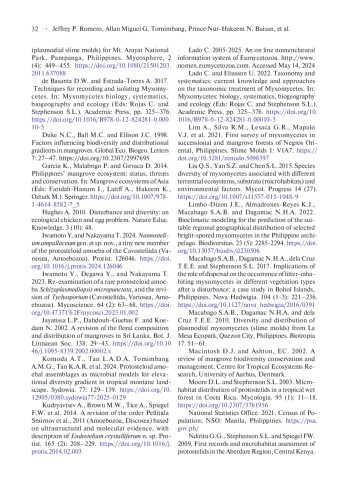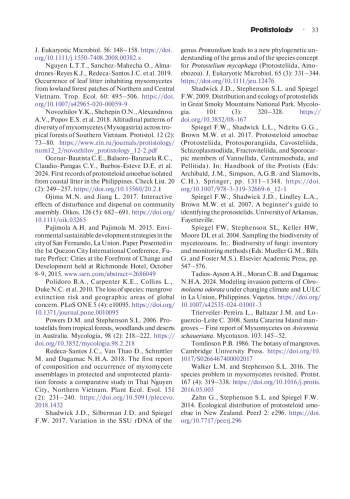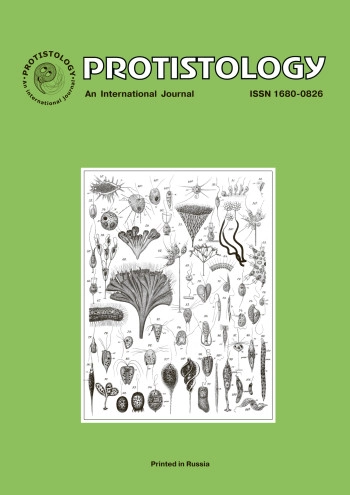Although the global distribution of eumycetozoans in terrestrial ecosystems with varying vegetation types has been a subject of a number of investigations during the past decade, there is still scarce to no available data from the mangrove forests, particularly in the Philippines. Hence, this study assesses and compares the occurrence and distribution of protosteloid amoebae inhabiting the mangrove ecosystem of San Fernando City, La Union, with the villages Biday and Catbangen as representatives. Aerial (AL) and ground (GL) leaf litter samples were used as substrates in isolating protosteloid amoebae and were subjected to moist chamber cultures. The 17 species belonging to 12 genera, from a total of 125 records, were described and reported in this study, with Protostelium mycophagum being the most often occurring species. Further results indicate that the ground microhabitat and the Biday site exhibited higher species diversity and abundance than the aerial microhabitat and the Catbangen site. Regarding species richness in the two leaf litters, GL hosted higher species richness than AL. The current research is one of the few that has assessed and surveyed the eumycetozoan distribution, occurrence, and ecology in the Philippine mangrove ecosystem. Furthermore, it demonstrates the potential for a mangrove forest to support diverse protosteloid amoebae growth.
Идентификаторы и классификаторы
- SCI
- Биология
Small phagotrophic slime molds known as protosteloid amoebae is a polyphyletic group of taxa belonging to Amoebozoa (Kudryavtsev et al., 2014; Spiegel et al., 2017).
Список литературы
1. Aduana-Alcantara A.A., Almadrones-Reyes K.J. and Dagamac N.H.A. 2023. Mangrove land suitability assessment using weighted linear combination: A case study of La Union Province Coastline, Philippines. J. Sustainability Resour. Manage. 2 (2): 83-91.
2. Aguilar M. and Lado C. 2012. Ecological niche models reveal the importance of climate variability for the biogeography of protosteloid amoebae. ISME J. 6 (8): 1506-1514. DOI: 10.1038/ismej.2012.12
3. Aguilar M., Spiegel F.W. and Lado C. 2011. Microhabitat and climatic preferences of protosteloid amoebae in a region with a Mediterranean climate. Microb. Ecol. 62: 361-373. DOI: 10.1007/s00248-011-9843-6
4. Balaoro-Banzuela R.C., Ocenar-Bautista C.E., Buebos-Esteve D.E., Claudio-Paragas C.Y. et al. 2023. Rapid diversity assessment of litter myxomycete assemblages in the upland and coastal terrains of San Fernando City, La Union, Philippines. Biodiversitas. 24 (5): 2877-2886. DOI: 10.13057/biodiv/d240542
5. Bernardo J.L.M., Arioder L.J.Q., Almadrones-Reyes K.J. and Dagamac N.H.A. 2018. Myxomycete communities occurring in fragmented forest patches in two municipalities of Laguna, Philippines.Community Ecol. 19: 289-299. DOI: 10.1556/168.2018.19.3.10
6. Buisan P.N.-H.N. and Dagamac N.H.A. 2021. Elucidating hidden slime mold diversity in Southeast Asia: A review of potential methods. Slime Molds. 1: V1A3. DOI: 10.5281/zenodo.5097135
7. Buot I.E., Jr., Origenes M.G. and Obeña R.D.R. 2022. Conservation status of native mangrove species in the Philippines. J. Wetlands Biodivers. 12: 51-65.
8. Cavalcanti L.H., Damasceno G., Costa, A.A.A. and Bezera A.C.C. 2016. Myxomycetes in Brazilian mangroves: species associated with Avicennia nitida, Laguncularia racemosa and Rhizophora mangle. Mar. Biodivers. Rec. 9 (31). DOI: 10.1186/s41200-016-0035-4
9. Dagamac N.H.A. and dela Cruz T.E.E. 2015. Myxomycete research in the Philippines: Updates and opportunities. Mycosphere. 6 (6): 784-795. DOI: 10.5943/mycosphere/6/6/12
10. Dagamac N.H.A., dela Cruz T.E.E., Rea-Maminta M.A.D., Cruz J.A.D. et al. 2017. Rapid assessment of myxomycete diversity in the Bicol Peninsula, Philippines. Nova Hedwigia. 104 (1-3): 31-46. DOI: 10.1127/nova_hedwigia/2015/0252
11. Dagamac N.H.A., Rea-Maminta M.A.D., Batungbacal N.S., Jung S.H. et al. 2015. Diversity of plasmodial slime molds (myxomycetes) in coastal, mountain, and community forests of Puerto Galera, Oriental Mindoro, the Philippines. J. Asia-Pac. Biodivers. 8 (4): 322-329. DOI: 10.1016/j.japb.2015.10.004
12. Dagamac N.H.A., dela Cruz T.E.E., Pangilinan M.V.B. and Stephenson S.L. 2011. List of species collected and interactive database of myxomycetes (plasmodial slime molds) for Mt. Arayat National Park, Pampanga, Philippines. Mycosphere, 2 (4): 449-455. DOI: 10.1080/21501203.2011.637088
13. de Basanta D.W. and Estrada-Torres A. 2017. Techniques for recording and isolating Myxomycetes. In: Myxomycetes biology, systematics, biogeography and ecology (Eds: Rojas C. and Stephenson S.L.). Academic Press, pp. 325-376. DOI: 10.1016/B978-0-12-824281-0.00010-5 EDN: CHQMCU
14. Duke N.C., Ball M.C. and Ellison J.C. 1998. Factors influencing biodiversity and distributional gradients in mangroves. Global Eco. Biogeo. Letters 7: 27-47. DOI: 10.2307/2997695
15. Garcia K., Malabrigo P. and Gevaña D. 2014. Philippines’ mangrove ecosystem: status, threats and conservation. In: Mangrove ecosystems of Asia (Eds: Faridah-Hanum I., Latiff A., Hakeem K., Ozturk M.). Springer. DOI: 10.1007/978-1-4614-8582-7_5
16. Hughes A. 2010. Disturbance and diversity: an ecological chicken and egg problem. Nature Educ. Knowledge. 3 (10): 48.
17. Iwamoto Y. and Nakayama T. 2024. Nannostelium ampullaceum gen. et sp. nov., a tiny new member of the protosteloid amoeba of the Cavosteliida (Variosea, Amoebozoa). Protist. 126046. DOI: 10.1016/j.protis.2024.126046
18. Iwamoto Y., Degawa Y., and Nakayama T. 2023. Reexamination of a rare protosteloid amoeba Schizoplasmodiopsis micropunctata, and the revision of Tychosporium (Cavosteliida, Variosea, Amoebozoa). Mycoscience. 64 (2): 63-68. https://doi.org/10.47371%2Fmycosci.2023.01.002.
19. Jayatissa L.P., Dahdouh-Guebas F. and Koedam N. 2002. A revision of the floral composition and distribution of mangroves in Sri Lanka. Bot. J. Linnaean Soc. 138: 29-43. DOI: 10.1046/j.1095-8339.2002.00002.x
20. Komoda A.T., Tan L.A.D.A, Tomimbang A.M.G., Tan K.A.R. et al. 2024. Protosteloid amoebal assemblages as microbial models for elevational diversity gradient in tropical montane landscape. Sydowia. 77: 129-139. DOI: 10.12905/0380.sydowia77-2025-0129
21. Kudryavtsev A., Brown M.W., Tice A., Spiegel F.W. et al. 2014. A revision of the order Pellitida Smirnov et al., 2011 (Amoebozoa, Discosea) based on ultrastructural and molecular evidence, with description of Endostelium crystalliferum n. sp. Protist. 165 (2): 208-229. DOI: 10.1016/j.protis.2014.02.003
22. Lado C. 2005-2025. An on line nomenclatural information system of Eumycetozoa. http://www.nomen.eumycetozoa.com. Accessed May 14, 2024.
23. Lado C. and Eliasson U. 2022. Taxonomy and systematics: current knowledge and approaches on the taxonomic treatment of Myxomycetes. In: Myxomycetes: biology, systematics, biogeography and ecology (Eds: Rojas C. and Stephenson S.L.). Academic Press, pp. 325-376. DOI: 10.1016/B978-0-12-824281-0.00010-5
24. Lim A., Silva R.M., Lesaca G.R., Mapalo V.J. et al. 2021. First survey of myxomycetes in successional and mangrove forests of Negros Oriental, Philippines. Slime Molds 1: V1A7. DOI: 10.5281/zenodo.5098397
25. Liu Q.S., Yan S.Z. and Chen S.L. 2015. Species diversity of myxomycetes associated with different terrestrial ecosystems, substrata (microhabitats) and environmental factors. Mycol. Progress 14 (27). DOI: 10.1007/s11557-015-1048-9
26. Limbo-Dizon J.E., Almadrones-Reyes K.J., Macabago S.A.B. and Dagamac N.H.A. 2022. Bioclimatic modeling for the prediction of the suitable regional geographical distribution of selected bright-spored myxomycetes in the Philippine archipelago. Biodiversitas. 23 (5): 2285-2294. DOI: 10.13057/biodiv/d230506 EDN: AQTRSB
27. Macabago S.A.B., Dagamac N.H.A., dela Cruz T.E.E. and Stephenson S.L. 2017. Implications of the role of dispersal on the occurrence of litter-inha-biting myxomycetes in different vegetation types after a disturbance: a case study in Bohol Islands, Philippines. Nova Hedwigia. 104 (1-3): 221-236. DOI: 10.1127/nova_hedwigia/2016/0391
28. Macabago S.A.B., Dagamac N.H.A. and dela Cruz T.E.E. 2010. Diversity and distribution of plasmodial myxomycetes (slime molds) from La Mesa Ecopark, Quezon City, Philippines. Biotropia 17: 51-61.
29. Macintosh D.J. and Ashton, EC. 2002. A review of mangrove biodiversity conservation and management. Centre for Tropical Ecosystems Research, University of Aarhus, Denmark.
30. Moore D.L. and Stephenson S.L. 2003. Microhabitat distribution of protostelids in a tropical wet forest in Costa Rica. Mycologia. 95 (1): 11-18. DOI: 10.2307/3761956
31. National Statistics Office. 2021. Census of Population; NSO: Manila, Philippines. https://psa.gov.ph.
32. Ndiritu G.G., Stephenson S.L. and Spiegel FW. 2009. First records and microhabitat assessment of protostelids in the Aberdare Region, Central Kenya. J. Eukaryotic Microbiol. 56: 148-158. DOI: 10.1111/j.1550-7408.2008.00382.x
33. Nguyen L.T.T., Sanchez-Mahecha O., Alma- drones-Reyes K.J., Redeña-Santos J.C. et al. 2019. Occurrence of leaf litter inhabiting myxomycetes from lowland forest patches of Northern and Central Vietnam. Trop. Ecol. 60: 495-506. DOI: 10.1007/s42965-020-00059-9
34. Novozhilov Y.K., Shchepin O.N., Alexandrova A.V., Popov E.S. et al. 2018. Altitudinal patterns of diversity of myxomycetes (Myxogastria) across tropical forests of Southern Vietnam. Protistol. 12 (2): 73-80. https://www.zin.ru/journals/protistology/num12_2/novozhilov_protistology_12-2.pdf.
35. Ocenar-Bautista C.E., Balaoro-Banzuela R.C., Claudio-Paragas C.Y., Buebos-Esteve D.E. et al. 2024. First records of protosteloid amoebae isolated from coastal litter in the Philippines. Check List. 20 (2): 249-257. DOI: 10.15560/20.2.1
36. Ojima M.N. and Jiang L. 2017.Interactive effects of disturbance and dispersal on community assembly. Oikos. 126 (5): 682-691. DOI: 10.1111/oik.03265
37. Pajimola A.H. and Pajimola M. 2015. Environmental sustainable development strategies in the city of San Fernando, La Union. Paper Presented in the 1st Quezon City International Conference, Future Perfect: Cities at the Forefront of Change and Development held at Richmonde Hotel, October 8-9, 2015. www.ssrn.com/abstract=2686049.
38. Polidoro B.A., Carpenter K.E., Collins L., Duke N.C. et al. 2010. The loss of species: mangrove extinction risk and geographic areas of global concern. PLoS ONE 5 (4): e10095. DOI: 10.1371/journal.pone.0010095
39. Powers D.M. and Stephenson S.L. 2006. Protostelids from tropical forests, woodlands and deserts in Australia. Mycologia, 98 (2): 218-222. DOI: 10.3852/mycologia.98.2.218
40. Redeña-Santos J.C., Van Thao D., Schnittler M. and Dagamac N.H.A. 2018. The first report of composition and occurrence of myxomycete assemblages in protected and unprotected plantation forests: a comparative study in Thai Nguyen City, Northern Vietnam. Plant Ecol. Evol. 151 (2): 231-240. DOI: 10.5091/plecevo.2018.1432
41. Shadwick J.D., Silberman J.D. and Spiegel F.W. 2017. Variation in the SSU rDNA of the genus Protostelium leads to a new phylogenetic understanding of the genus and of the species concept for Protostelium mycophaga (Protosteliida, Amoebozoa). J. Eukaryotic Microbiol. 65 (3): 331-344. DOI: 10.1111/jeu.12476
42. Shadwick J.D., Stephenson S.L. and Spiegel F.W. 2009. Distribution and ecology of protostelids in Great Smoky Mountains National Park. Mycologia. 101 (3): 320-328. DOI: 10.3852/08-167
43. Spiegel F.W., Shadwick L.L., Ndiritu G.G., Brown M.W. et al. 2017. Protosteloid amoebae (Protosteliida, Protosporangiida, Cavosteliida, Schizoplasmodiida, Fractoviteliida, and Sporocarpic members of Vannellida, Centramoebida, and Pellitida). In: Handbook of the Protists (Eds: Archibald, J.M., Simpson, A.G.B. and Slamovits, C.H.). Springer, pp. 1311-1348. DOI: 10.1007/978-3-319-32669-6_12-1
44. Spiegel F.W., Shadwick J.D., Lindley L.A., Brown M.W. et al. 2007. A beginner’s guide to identifying the protostelids. University of Arkansas, Fayetteville.
45. Spiegel FW, Stephenson SL, Keller HW, Moore DL et al. 2004. Sampling the biodiversity of mycetozoans. In:. Biodiversity of fungi: inventory and monitoring methods (Eds: Mueller G.M., Bills G. and Foster M.S.). Elsevier Academic Press, pp. 547-576.
46. Tadios-Ayson A.H., Moran C.B. and Dagamac N.H.A. 2024. Modeling invasion patterns of Chromolaena odorata under changing climate and LULC in La Union, Philippines. Vegetos. DOI: 10.1007/s42535-024-01001-3
47. Trierveiler-Pereira L., Baltazar J.M. and Loguercio-Leite C. 2008. Santa Catarina Island mangroves - First report of Myxomycetes on Avicennia schaueriana. Mycotaxon. 103: 145-52.
48. Tomlinson P.B. 1986. The botany of mangroves. Cambridge University Press. DOI: 10.1017/S0266467400002017
49. Walker L.M. and Stephenson S.L. 2016. The species problem in myxomycetes revisited. Protist. 167 (4): 319-338. DOI: 10.1016/j.protis.2016.05.003
50. Zahn G., Stephenson S.L. and Spiegel F.W. 2014. Ecological distribution of protosteloid amoebae in New Zealand. PeerJ 2: e296.
Выпуск
Другие статьи выпуска
Thecamoeba onigiri n. sp. (Amoebozoa, Discosea, Thecamoebida) was isolated from a moss sample collected in the surroundings of Lake Baikal (Russia). The amoebae of this species belong to the striate morphotype and have a single rounded nucleus. The nucleolar material of T. onigiri can be organized in different ways depending on the age of the culture. The most common was a nucleus with a nearly spherical eccentric nucleolus, sometimes located very close to the nuclear envelope. The surface of such a nucleolus was rough and uneven. This type of nucleolar organization was observed in one- to two-week-old cultures. In contrast, a centrally located rounded nucleolus with smooth surface predominated in three- to four-week-old cultures. This type of the nucleolus corresponds to the classical “vesicular” nucleus and is similar to that found in amoebae of “T. quadrilineata species group”, but differs in having lacunae that are more peripheral. Molecular phylogenetic analysis based on 18S rRNA gene sequences showed that T. onigiri forms a clade with T. astrologa as part of a larger group that also includes the “T. quadrilineata species group” and T. aesculea. Meanwhile, two species of Thecamoeba demonstrate polymorphism of the nucleolar material arrangement, and both these species are phylogenetically close.
Protists inhabit waters with different salinities up to saturation, and play significant roles in the food webs. In hypersaline environments, the simplified communities are composed of mainly pro- and eukaryotic halophilic microorganisms. The aim of this study was to characterize the prokaryotic assemblages associated with uniprotist cultures of heterotrophic and phototrophic halophilic protists isolated from inland saline water bodies and maintained under laboratory conditions for a long time. The cultures were represented by chlorophycean algae Dunaliella and Asteromonas, as well as by heterotrophic protozoa of the phylum Heterolobosea. DNA metabarcoding revealed that the prokaryotic assemblages differed drastically between the phototrophic and heterotrophic protists in richness, diversity and taxonomic composition. Generally, the prokaryotic assemblages of Heterolobosea protozoa were richer than those of chlorophycean algae. In the algal microbiomes, only few prokaryotic genera were revealed. They were represented by the bacterial phylum Pseudomonadota and the archaeal phylum Halobacteriota. Rather diverse prokaryotic assemblages were associated with the cultures of halophilic Heterolobosea protozoa. They were composed of the phyla Pseudomonadota, Bacteroidota, Balneolota, Thermodesulfobacteriota, Halobacteriota, and Nanohaloarchaeota. Predicted functional profiles of the prokaryotic assemblages revealed the pathways responsible for close metabolic interactions between the halophilic protists and their prokaryotic associates, including synthesis of organic osmotic solutes and their conversion, degradation of sugar and organic aromatic compounds, biosynthesis of cofactors and vitamins. The dramatic differences between prokaryotic assemblages of heterotrophic and phototrophic protists suggest the existence of different selection mechanisms shaping microbiomes of the halophilic protists that still have to be elucidated.
The PII superfamily consists of widespread signal transduction proteins found in all domains of life. The most conserved PII-interactor across oxygenic phototrophs from cyanobacteria to Archaeplastida is the key enzyme of the ornithine/arginine synthesis pathway, N-acetyl-L-glutamate kinase (NAGK). T-loops represent the major PII-receptor binding element and are involved in the interaction with NAGK. Within the class Mamiellophyceae, only the genus Micromonas contains species with the PII protein. Bioinformatic analysis revealed that the PII protein of Micromonas pusilla (MpPII) has an unusually prolonged T-loop. Here, we performed the coupled enzyme assay and showed that MpPII has no remarkable influence on NAGK activity. An engineered variant of MpPII with deletion of four additional amino acids (AATD) in the T-loop restored the ability of this protein to relieve NAGK from feedback inhibition by arginine in a glutamine-dependent manner. The findings are discussed in the context of unusual plasticity of the PII protein family during the evolution of Archaeplastida.
In recent decades, infection of the European honey bee Apis mellifera with the highly virulent microsporidium Vairimorpha (Nosema) ceranae has become globally prevalent. It causes serious losses in beekeeping worldwide and requires new approaches to control bee nosemosis. Since this intracellular parasite has retained components of the RNA interference pathway, double-stranded RNA (dsRNA) treatment of insects may be effective in controlling V. ceranae infection. Inhibition of microsporidia growth in bees fed with 1.8 or even 0.04 μg dsRNA per ml of sugar syrup has been reported in the literature. Considering the crucial role of the genome’s DNA replication machinery for any cell, we synthetized in vitro dsRNA fragments of four V. ceranae genes encoding two subunits (delta and epsilon) of DNA polymerase, helicase and topoisomerase II and fed them to the infected bees with a relatively low dose of 1 µg per ml of sugar syrup. Surprisingly, PCR and qPCR analyses of V. ceranae growth in the midgut of dsRNA-treated insects at 7- and 12-days post-infection revealed neither inhibition of microsporidia growth nor downregulation of target genes. It is worth noting that we collected worker bees of different ages directly from a hive, to simulate the conditions during colony treatment in apiaries. At the same time, newly emerged insects reared in the laboratory were used in the successful experiments mentioned above. This suggests that bee housing conditions as well as gut content may affect the efficiency of RNA interference and requires further increase in dsRNA doses or their mixing with nanoparticle carriers.
Статистика статьи
Статистика просмотров за 2025 год.
Издательство
- Издательство
- ИНЦ
- Регион
- Россия, Санкт-Петербург
- Почтовый адрес
- Санкт-Петербург, 194064, Тихорецкий проспект, 4
- Юр. адрес
- Санкт-Петербург, 194064, Тихорецкий проспект, 4
- ФИО
- Томилин Алексей Николаевич (Руководитель)
- E-mail адрес
- cellbio@incras.ru
- Контактный телефон
- +7 (812) 2971878
- Сайт
- https:/incras.ru
